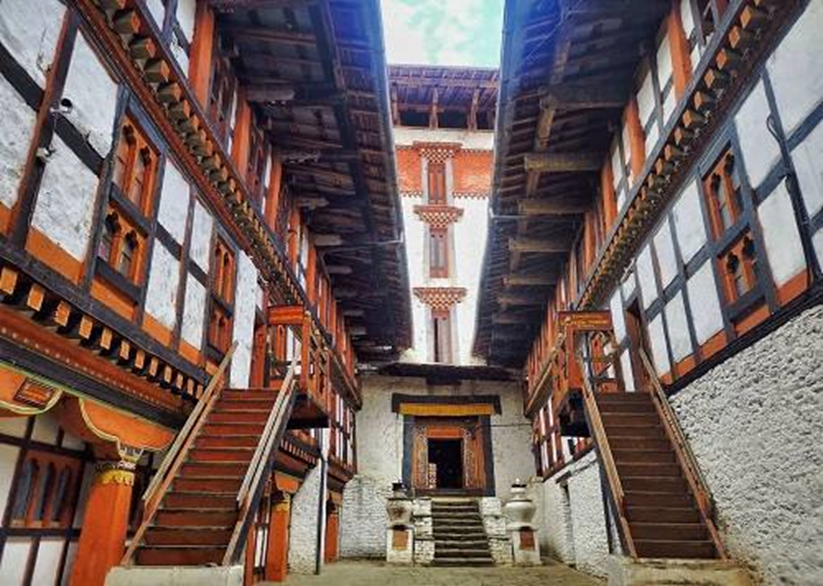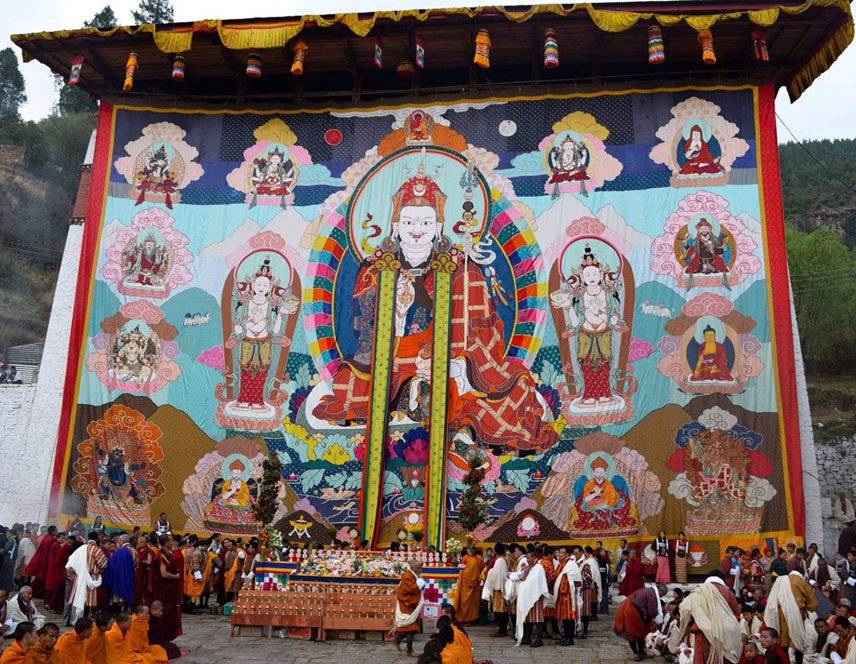Bumthang is known for being one of the most holistic places in eastern Bhutan. Many sacred temples, monasteries, and cultural sites in the district mark the significance of people’s spiritual beliefs and cultural roots.
Out of the many areas, Jakar, which translates to “White bird in English is a place in Bumthang that earned its name from a myth of a white flying bird. The bird is believed to have signalled the precise location of constructing a monastery in around 1549. Every year, locals gather in Jakar Dzong to witness the festival of Jakar Tshechu.

An exterior view of Jakar Dzong. Source: Bhutan Life Exposure.

Inside Jakar Dzong. Source: Drukasia

Jakar Tshechu in held in Jakar Dzong. Source: Yak Holidays International
During Tshechus, Buddhist monks perform sacred mask dances called the ‘Cham’. These dances are based on the experiences of Guru Padmasambhava who is one of the greatest spiritual influencers and figures who brought Buddhism to Bhutan during the 8th century. People also either take part in the dance or chant prayers and prostrate to honour the legacies of Guru and anticipate being blessed with teachings of ‘Dharma’ through the performances. Moreover, the festival also showcases different types of traditional folk songs.

Costumed Mask dances performed by monks in Jakar Tshechu. Source: Breathe Bhutan
Tshechus (literally translates to the 10th day of the month) are performed in different parts of Bhutan on the 10th day of the Bhutanese Calendar but on different months. Many tourists and visitors witness the thrilling experience of Jakar Tshechus every year and explore other religious aspects of Jakar and Bumthang.
The schedule for Jakar Tshechu this year and next year are as follows:
Dates: 1st – 3rd November, 2022
22nd -24th October 2023
Source: Firefoxtours
Offices, schools, and shops in the localities usually remain closed during Tshechus. However, large markets and fairs at locations near the main celebration are congregated instead.
Monks in Tshechu Perform different types of dances some of which are:
1. Dramiste Nga Cham
This authentic mask dance represents mythical and real creatures who are different forms of spiritually enlightened beings. The ritual song for this cham is executed by beating the drums of made up of animal skin.
2. Zhanak Cham
In this dance people only wear costumes and black hats. They do not wear any sort of masks. People believe that this dance is meant to purify the setting and transform it into a field with a high level of enlightened energy.
3. Dance of Pholey Moley
For this type of masked dance, monks usually perform a comic farce based on the relationship between a married couple and an outsider. Dancing actors showcase the concept of rage, comedy, and confusion and entertain the viewers.
4. Ging Tsholing Cham
The exotic and fearsome mask dance of Ging Tsholing Cham signifies terrifying forms of wrathful deities that summon evil spirits. They also wear a certain type of skirts and props to dance.
5. Dhurdag Cham
Dancers in skeletal death masks made up of wood perform this Cham along with other costumes. This dance is believed to destroy some obstacles to enlightenment such as fear, desire, pride, attachments, and ego.
The three-day festival in Jakar is usually filled with people in their brightest and most colourful outfits. These festive clothing are usually vibrant versions of the national attire, Ghos and Kiras as bright colours have auspicious significance according to Buddhist beliefs.

People attending Jakar Tshechu
Source: Flickr
The unfolding of Thongdrels (A large scroll that has religious images) also takes place during the celebrations, typically raised before sunrise and unveiled by morning. The sight of the huge image is believed to cleanse the sins of people and ward away all evil energy.

Unfurling of a Thongdrel/ Thangka in Tshechu. Source: Facebook: Authentic Bhutan Tours
Comentarios